The previous report was posted shortly after our arrival in Maun, a bustling little town in northern Botswana which serves as the starting point for safaris into the Okavango Delta region and the northern part of the Central Kalahari Game Reserve. As can be expected in towns that bustle and lie close to safari destinations, excitement hung in the air, while all sorts of serious-looking vehicles drove off and on, some departing into the bush, some returning from their adventures, others buying supplies at one of the supermarkets. There were garages where those who had been unfortunate could have a go at getting their cars fixed.
We met an elderly couple from Cape Town who had been unfortunate, and continued to be unfortunate. They had attempted to cross a river in their Mercedes 4×4, gone in too deep and sustained all sorts of damage, like a turbocharger that no longer turbocharged anything. They had somehow brought their car to Maun – that was six weeks ago, they said. Since then, they had been frustrated about mechanics who only seemed to make things worse, they said. They had managed to get an emergency extension on the period they were allowed to stay in the country, but with only a couple of days left of that, when a mechanic started the engine to check the progress of the repairs, the car was still belching white smoke (white smoke… isn’t that a sign of a blown head gasket?). They sighed and said that their car was not so good in water, they were going to get a different car. If they ever got this mess sorted.
The Okavango Delta is a destination for visitors on package tours and 4×4 enthousiasts alike. In the first few months of every year, seasonal rains in Angola push the water of the Okavango river southeast until it arrives at a level inland area where it branches out. For several more months, the water continues to advance into riverbeds that had been dry, attracting an abundance of wildlife and making river crossings hazardous. Then, in the dry season, the water simply evaporates, drying up the delta, until a new cycle of rain and flooding begins.
While the package tourists come to see and photograph wildlife, the 4×4 drivers are also drawn by the promise of adventure and challenging driving conditions. But more than one driver unwittingly gets into a situation that is more than he bargained for, leading, in some cases, to the unceremonious death of the prized vehicle.
Since we are not experienced 4×4 drivers and time constraints forced us to make choices, we thought we would spend just two nights in Moremi National Park, which lies in the delta and is not too far from Maun, and then turn around and head towards Namibia. Charlotte found an agent who could book our two nights at a campsite in the park. For what we paid, one would expect something along the lines of:
18:00 Lions perform a traditional dance around the campfire.
19:00 Buffet of grilled game meats, supplemented with local starches and vegetables.
21:00 Time to get into your duvets, while hippos hum you to sleep with a typical a cappella lullaby.
The reality was less hollywoodian. Although we did see a lot of animals, we had seen most of them before, and quite a few even during our drive to the park. Other travellers who had written about their experiences had commented on how expensive it was, but so worth while because they had found elephant dung next to their car in the morning. Sure, we saw piles of shit, and we heard hippos nearby during the night. But was that it? I had asked the lady at the reception desk what kinds of precautions we should take, with all these wild animals around. ‘You have to be careful’, was the only reply I got.
I was unsure how being careful would keep us from being turned into catfood by the superlative felines that were said to live in the area and could walk freely through our camp, but seeing how other people behaved, I relaxed. We met some wonderful people who came to camp next to us and spent a whole afternoon with them, sitting outside under a tree, talking and drinking wine.
Only the next day, we would be reminded once more of the lions and cheetahs we hadn’t seen. As we drove through the park towards the gate, a game drive vehicle, coming from the opposite side, stopped to talk to us. The guide asked us, ‘What have you seen?’ and listened patiently while we named all the animals that didn’t matter. ‘No cats?’ Errr, no, no cats. ‘We saw some tracks back there’, he said, casually pointing his thumb behind him, and I thought, shit, that should have been my line.
We thanked him and wished him luck. And then took some detours on our way out, taking paths less travelled. During one of those, while avoiding a muddy part of the trail, we managed to get stuck in another, less obvious patch of mud. I got out to assess the situation. One front wheel turning freely, one rear wheel as well. A combination of unfavourable factors suddenly added up: stuck in the mud, path less travelled, possible presence of ‘cats’ and no cellphone coverage. The word ‘predicament’ came to mind. But there was one decisive factor that worked to our advantage: with front and rear diff lock on, we easily got out and onto firmer ground. Paraphrasing Trevor (our 4×4 instructor in Cape Town), I’d say that front and rear diff lock has to be the best invention since the corkscrew.
After the Moremi Game Reserve, we did turn back and headed towards Namibia, but not without spending one more night in Maun for several reasons. Two of them were called mopane.
You see, we had been buying firewood at petrol stations (collecting firewood in nature reserves is a big no-no) which had invariably been Namibian hardwood. Once it burned properly, it had yielded excellent embers to grill on but it had been very reluctant to burn. The local wood from mopane trees, which was sold in and around Maun by the side of the road by people looking to supplement an otherwise meagre income, was a softer wood that was much easier to make a fire with and still made decent charcoal.
The person who had told me this had also mentioned the mopane tree’s inhabitant, the mopane worm, which happens to be a regional delicacy that he fully expected me to know about. I didn’t, so I sampled a couple of them, fresh from the grill, during our stopover in Maun. About the size of my little finger (the one that is still whole), crisp on the outside and fleshy on the inside, it was indeed succulent and tasty.
After a fairly eventless drive to the Namibian border (except for a foot-and-mouth disease checkpoint where we were told we came from an infected area and were given the choice between surrendering a beautiful t-bone steak and some lamb chops, or cooking them on the spot),
we continued west and visited Charlotte’s friend Ingeborg who owns and runs a thoroughbred horse operation north of Windhoek. We then headed towards Spitzkoppe, following advice from Daan and Cyril, who we had met earlier (you want to see nice landscapes? Go to Spitzkoppe, and then head south).
Spitzkoppe is a mountain that has been dubbed ‘the Matterhorn of Namibia’. Who would think of such a silly comparison? Probably the same people who come up with ‘the Paris of the west’ or ‘the Paris of the east’ (many towns and cities have been called that) or ‘the Giethoorn of the south’ (The Italian hamlet of Venice has been compared to the Dutch town that is world-famous for its canals).
Anyway, the Matterhorn of Namibia looks pointy from afar, but as you approach it, it begins to sag and droop. From up close, it reminds the visitor of Uluru in that it could well be a sacred mountain, rising in its granite monolithicness from a basically flat landscape. Also, it boasts rock paintings which can only be visited with a guide (which we didn’t do).
From this description, Spitzkoppe may sound like it is not a big deal, but it is. For one thing, there’s the geology. A long time ago, magma bubbled to the earth’s crust but did not break through it. Over millions of years, the softer materials around what had solidified as all sorts of granite shapes then eroded away, leaving the granite exposed.
And then there are the camping possibilities. At the base of the mountain, there are a number of official camping spots, many of them spaced so far apart that you can have the illusion of camping wild, an illusion that is enhanced by the very basic facilities: each spot has a place to make a fire and an outhouse, called long-drop toilet here. Even these, by the way, are not essential. We have used our shovel to dig fireplaces and latrines before.
We found our perfect spot to camp, and while I busied myself setting up camp and marvelled at a flock of Rosy-Faced Love-Birds (a Namibian species of small parrots) settling in a tree nearby, Charlotte went off to watch the sun set and came across a band of rock hyrax and two klipspringers.
The following day, we went on a long hike around Spitzkoppe and the neighbouring hills. We returned to our campsite exhausted, but the beauty of the place would leave a deep impression.
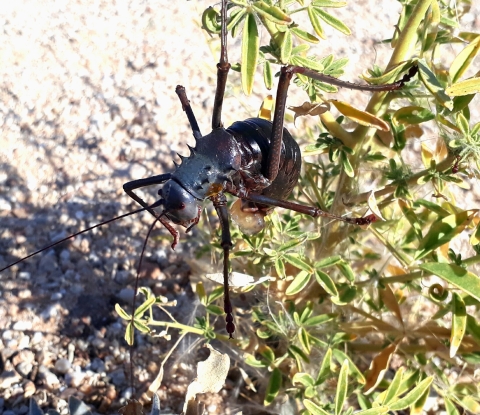
I believe what we are looking at here is a long-legged armoured katydid laying eggs. They are everywhere in this area.

He flagged us down, standing next to a beat-up old Toyota. Speaking in Afrikaans, he told us that he was on his way to a funeral but had run out of diesel. He then produced a hose and a jerrycan and began to syphon diesel with the ease and skill of one who has done this many times before. Then he asked for food (kos) and clothing (klere). And then for a hundred dollars. I let him have the diesel.
More wild camping was to follow. Charlotte had found out about the Namib Naukluft National Park, which has similar campsites throughout large parts of the Namib desert. We drove to the seaside resort of Swakopmund to buy permits from the NWR (Namibian Wildlife Resorts) and learned that you pay for the number of nights you want to stay in the area, and you can stay at any of the designated sites. No booking, no reception, no facilities, no nothing.
No body, as it turned out. Nobody. We booked only two nights, stayed in two spots, were the only ones both times and ended up wishing we could stay much longer.
The first site we stayed at consisted of a few spots located around the same phenomenon of bubbling magma and subsequent erosion, albeit with slightly different resulting shapes.
The second site was a wooded area on the bank of a dried-up river. The stony desert had suddenly shown large cracks, then tentative greenery, and we descended into what could have been mistaken for a pine forest. People lived nearby – from what? – and several animals kept us company: bulbuls, starlings and a few skinny dogs that happily and docilely accepted whatever we tossed at them. We had bought a loaf of excellent bread in Swakopmund, but most of it went to the dogs.
We were not far now from what everybody thinks of when you mention Namibia: the red sand dunes at Sossusvlei.
4×4’s like ours converged on Sesriem, the departing point for the 60-something-kilometer-long tar road that ends in the middle of the famous dunes. I was sceptical, ready to accept another overrated tourist attraction that you ‘have to have done’. We arrived at the campsite at Sesriem that lies just within the park’s boundaries and found the campsite fully booked. Just as well we had reserved our spot a few days earlier in Swakopmund, at the NWR office…
There are two gates. The first one gets you into the park and the campsite, which is where we were. It opened at 06:45, right around sunrise. The second gate, just past the campsite, opened an hour earlier, allowing us a one hour head-start compared to those outside and an opportunity to get to what is called dune 45 (45 kilometers away from Sesriem) in time to climb it and watch the sunrise, keeping in mind that there is a 60 km/h speed limit in the park.
What is the big deal about being on dune 45 at sunrise? I honestly don’t know. As soon as the gate opened, cars raced to the dune, oblivious of the speed limit, and in the end, all the people in them saw was a sunrise like we have seen many times before.
The reward of the trip was further down the road, where it ended. Curiously, the end was not the end. The tar road ended, but a sand trail went on for another few kilometers to the ‘real’ end of the road. Shuttle services helped people bridge those last few kilometers at inflated prices, but 4×4’s were allowed to continue at their own peril.
Even as we were deflating our tyres, we saw people rocking a 4×4 rental from side to side on the sand trail in an effort to get it unstuck, and then give up. Our tyres deflated, we manoeuvered in front of them, got out the tow strap and pulled them out. A bit further, we passed another rental, buried up to the axles in sand and abandoned. Nothing to do here.
At the ‘real’ end of the road, we saw people walking up several dunes. We picked the highest one because it offered the promise of the nicest photos. It probably took us an hour to get to the top, it was serene there and quite beautiful, the sand we sat down in was hot on the side the sun shone on and cold on the other, and then a group of youngsters arrived, gregarious and boasting about getting up in 45 minutes. We had seen people following a guide who had run down the dune towards a salt pan, and did the same. The sand vroomed below our feet as we bounded down, feeling invincible.
The salt pan that is known as Deadvlei was easily crossed, our car parked not far behind it. Like what had happened earlier, sunshine and effort had worn us out, but what we had done, seen and lived was priceless.
The evening at the same campsite was filled with the yelling of other people’s children and the repetitive bass riffs of some far-away music. Time to leave and get back into that world where there is nobody else, just silence and stars… What can be more important?
As we drove further south, or east or west for that matter, we would see more and more faces of the desert. The Namib is a million colours, a million shapes, a landscape of age-old petrified vision that changes faster than the eye can follow.
Unless you stop. And contemplate. The desert is addictive.
We spent a night at an abandoned campsite (a former community project that had not worked out) halfway up Mount Brukkaros, an extinct volcano. We had thought we’d stay longer, but a howling northwesterly wind tried to blow us off the mountain, and then, during a hike into the crater, I slipped and pulled a quadricep, instantly becoming a cripple for who knows how many days.
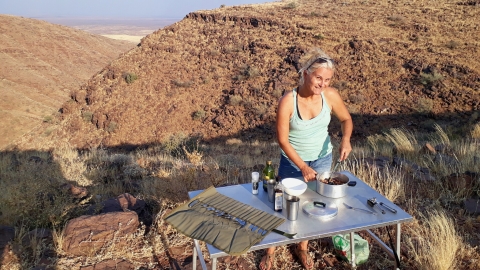
Charlotte preparing our signature three-bean salad. A can of kidney beans, a can of lima beans, you get the idea. With only a few days to go before we have to return the vehicle, it’s time to start using up our emergency food.
We thought it better to heed the mountain’s warnings and leave. My left leg was unusable, so Charlotte had to drive us down to the plains on a gnarly 4×4 trail. She didn’t like the prospect one bit, but after we had regained the easy roads, she mused for a while and then smiled and said, ‘I would like to do more of that’.
The last few nights were spent at guest farms, with memorable meals (springbok medallions and kudu carpaccio), memorable campsites (by a river that exploded with animal calls at sunrise and sunset) and memorable encounters (with three wonderful, good-hearted Australians).
…
We returned the vehicle yesterday. Camping in beautiful spots, coffee on chilly mornings, the thrill of having animals around, the breathtaking landscapes – finished. It has come as more of a shock than I thought. Now what? Let’s start by taking a bus to Swakopmund today, then we’ll see.
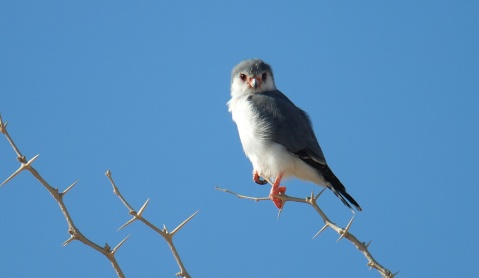
Often, a Pygmy Falcon lives in a symbiotic relationship with the Sociable Weavers. It sounds the alarm when bigger raptors or snakes approach. In return, it gets room and board: an unoccupied chamber in the nest and the occasional chick to snack on.




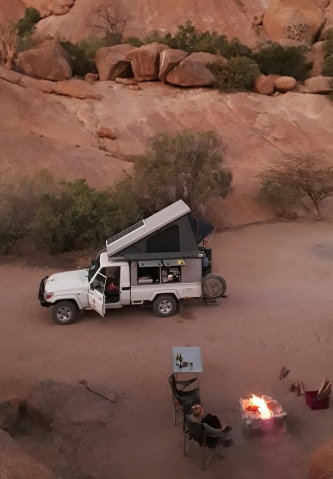


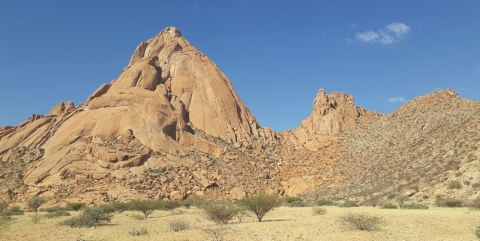

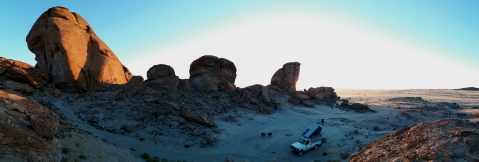

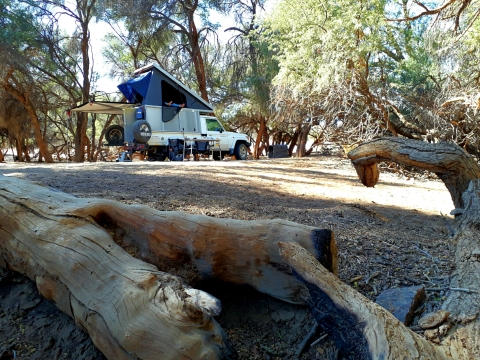
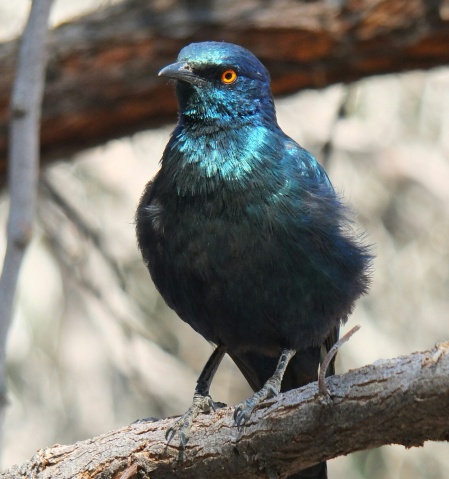


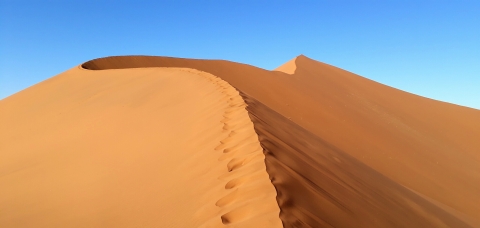

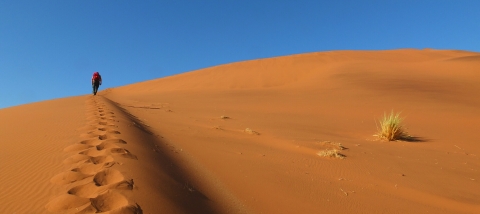
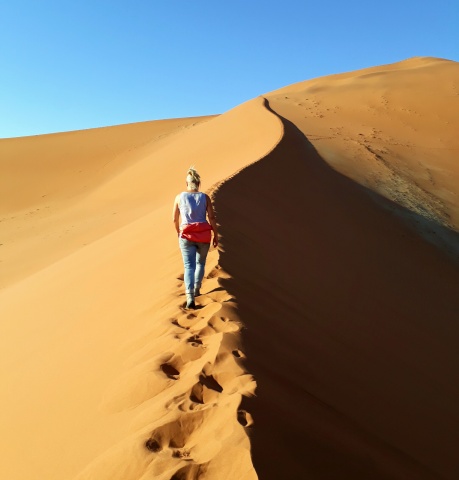



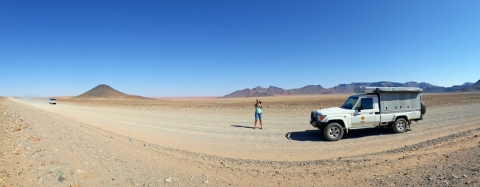
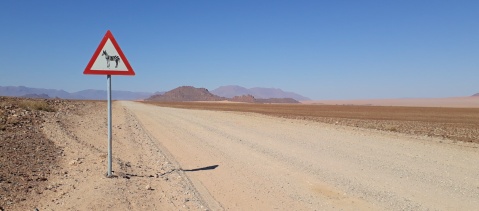



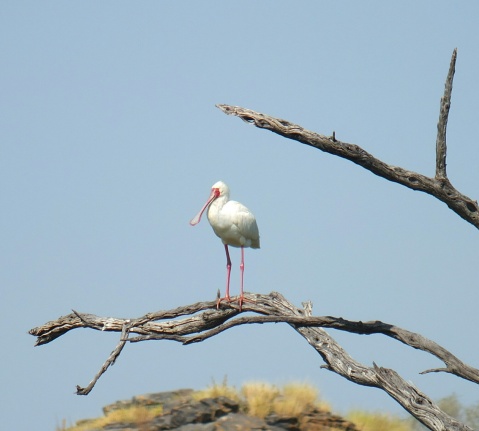

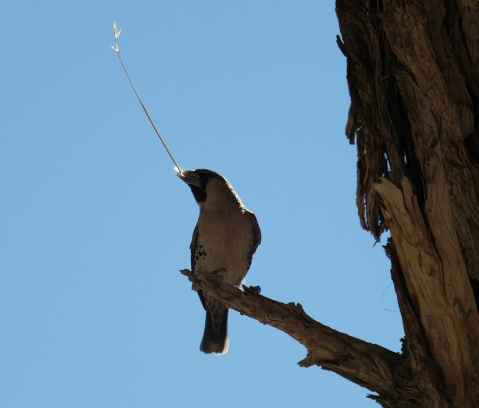
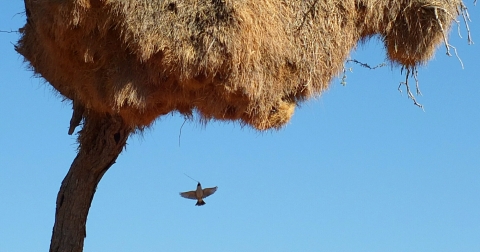

1 Jul 2017 at 09:39
Great chapter, great photos and I like your short haircut Richard ! Look forward to finding out what comes next … xx
1 Jul 2017 at 09:52
Thank you!!
One day, we just took the beard trimmer to the hair on my head 🙂 . Very convenient!
1 Jul 2017 at 12:31
I look forward to each blog,Richard. I feel as if I am there with you both. The wildlife and landscapes and incredible !
1 Jul 2017 at 16:52
Thank you Jane, nice to see you here!
2 Jul 2017 at 12:25
Thank you for the update Maun is is a special little town … Trevor
I am so glad you are doing this trip… and yes I smile at the silly people one encounters and the WONDERFUL places you are going and things you are seeing..
You are igniting thoughts in my head .. I am so glad we met .. J
Untitled
2 Jul 2017 at 16:36
The past two months have been eventful, instructive and very exciting. I’m sure we will be doing more of this!
29 Aug 2017 at 15:21
Ik liep wat achter merk ik nu… zó leuk en herkenbaar om te lezen van Namibië. Prachtig!
Heel fijn dat je weer reist en blogt. Blijft een fijne mee-beleving door je intense manier van beschrijven. Succes met de GR!
Liefs, Yvonne
1 Sep 2017 at 09:03
Dank je Yvonne! Leuk van je te horen. Hoop je ook weer eens te zien!